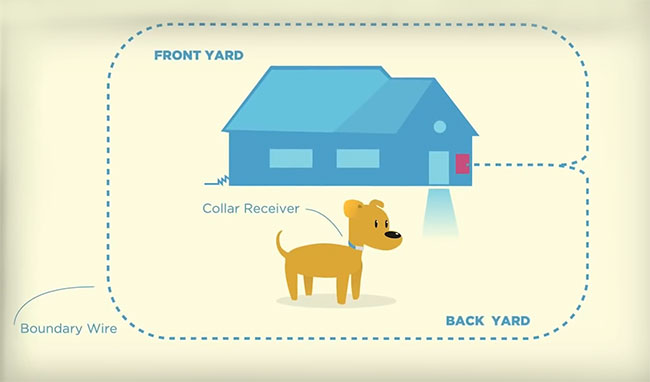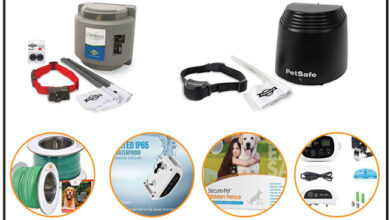
The best answer to the question of: how well do electric dog fences work would be: very well.
But when it comes to your lovely pet, a short answer won’t suffice. You want to know all the details, because the devil is in the details!
Electric dog fences are perfect for keeping your dog contained in its area. It makes a geolocation of sorts!
For various reasons, it is not always a good idea to let your dog wander all over, especially because they get curious and they can be all over things.
Instead of keeping your canine friend penned up in their kennel all the time, let them stay free, but create boundaries, with wireless or wired electric fences.
You can read petsafe in ground fence reviews to know the best electric wired fences. But first, read this writeup to see how these, and other fence designs work.
They Come in Wired and Wireless Designs
Electric wire fences come in two designs – the wired and the wireless designs. Having more options to choose from is better because we have different needs.
If it is not legally permitted to build a chain link or wooden fence on your property, the wired and wireless electric fences are good for controlling the movement of your dogs.
The wired fence requires some work for installation. For instance, you have to bury it underground and this can be hard or easy depending on the ground.
Wireless fences are cheap to buy and install, but their range is limited. Therefore, they are most appropriate when you don’t have much yard space. Their benefit is in the ease of installation.
To sum this up, the wired pet fences are good for people with large yards, because their range is not limited. You can buy more wire if you need to.
The electric wireless fences are good for small yards.
How Powerful is an Electric Fence for Dogs?
How powerful you want the electric fence for pets to be depends on the character of the dog. Some dog species are clingy, some are carefree, others stubborn, and so on.
Other species can be quite hard-headed. As you can see, the containment measures you employ depends on the dog.
From various studies, the Siberian Husky, Bulldog, Jack Russell Terrier, Scottish Terrier, and the Weimaraner are stubborn.
To keep such dogs contained in their geo-location, you might need to use a higher voltage electric fence than you would on gentler species.
That said, experts say you should use at least 4000 volts for the stubborn dog species and use at least 2000 volts for gentler ones. It is best not to exceed 6000 volts as anything above this is too brutal.
It is also possible for electric wire fences to cause injury so keep the voltage to the recommended minimum rather than the maximum, for your dog.
Electric Dog Fences are Safe and Reliable
You can rely on electric dog fences to keep your dog contained all the time, or at least 95% of the time. Why 95%, you may wonder?
Nothing in this world is foolproof and these fences are not too. They rely on a power source, and while they might not malfunction, the power source might.
Here is a breakdown of the reliability of either the wired or wireless electric pet fence.
Wired electric fences – These are the best, and you may consider them 100% safe for the animal. When there is a malfunction anywhere in the system, it shuts down, so it cannot shock your dog.
Wireless electric fences – If something happens to the wireless signal and the system malfunctions, you cannot predict how the show will go down.
Mostly, it will shock your dog, causing trauma. While there is almost zero risk of malfunctioning, there is still a small chance of risk.
Will an Electric Fence Keep a Big Dog in?
Well, a dog, even a medium sized one can escape, if they are really determined to escape.
Nothing can keep them in!
This is why after installing the fence, you need to train the dog. A well trained dog will obey the electric impulses passing through its collar to its body.
Irrespective of the size of the dog, it will stay contained if it is well trained. If it is not trained properly, it “can” ignore the signal and get over the fence anyway.
So the answer to the question of keeping big dogs in is a strong yes, and a small no. 99% of the time, the fence will keep the dog inside.
But, if a stubborn dog sees something he would like to chase on the other side of the fence, he might ignore the impulses and cross over anyway.
There will be pain. And this brings another predicament. If the dog feels pain going over the fence, he will not come back inside over the fence, to feel pain again. So he will stay “locked out” until you can disable the system and bring him in again.
Conclusion
Man’s best and most faithful friend sometimes misbehaves. The little spark of naughty in canines can come up any time. This is why you need to keep the dog contained within its perimeter.
To do this, you shall use an electric wireless or wired fence. If you have a large space and you want the dog to move a lot, use the wired electric fence. If you have a small yard space, perhaps you should keep a smaller dog and use the electric wireless fence.
The idea is to keep the dog within its boundaries but with enough freedom of movement. Every dog needs to move around a lot for exercise.

